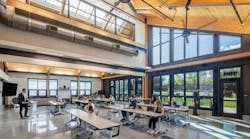A brief history of windows in America
It’s easy to lose sight of the significance of historic windows when all they seem to contribute to the building aesthetic is peeling paint, rotting wood, corroding steel, or broken glass. To appreciate the architectural worth of aging windows, we must look back, briefly, at their origins.
The earliest American windows were wood casement windows, hinged at the sides. By the early 1800s, sliding single- and double-hung windows had come into popular use. However, devastating fires in a number of U.S. cities during the late 19th century led to the widespread adoption of strict fire codes, which decreased the prevalence of wood windows.
At the same time, the Industrial Revolution brought about major advances in rolled steel, permitting the mass production of steel windows. These fire-resistant frames and sashes became the standard for factories and commercial buildings, as well as for larger residential and university buildings, while wood windows continued to dominate the single-family residential market.
Steel remained the primary material for industrial, commercial, and institutional windows in the United States well into the 20th century. The strength of steel permitted larger expanses of glass, which enabled the thin profiles and repeated window patterns of Art Deco and early Modernist buildings. Then, after World War II, aluminum windows gained popularity due to their lower price and non-corroding properties. Toward the end of the 20th century, wood windows also fell out of fashion, as many homeowners replaced the original windows on their turn-of-the-century houses with vinyl, both for its inexpensiveness and for its promise of minimal maintenance.
Unfortunately, the replacement of original wood or steel windows with cheaper materials can significantly impact building appearance. Aluminum, for example, is much weaker than steel, requiring bulkier frame profiles that can destroy the delicate look afforded by multi-pane steel windows. Likewise, vinyl may discolor and warp over time, making it a far less durable material over the long term than the original wood.
The good news for building owners is that options for treating deteriorated historic windows are plentiful. Energy-saving retrofits, repair, or parts replacement can restore existing windows to like-new functional condition. Should replacement be called for, it is often possible to locate or custom-make historic replicas that won’t compromise building character.


